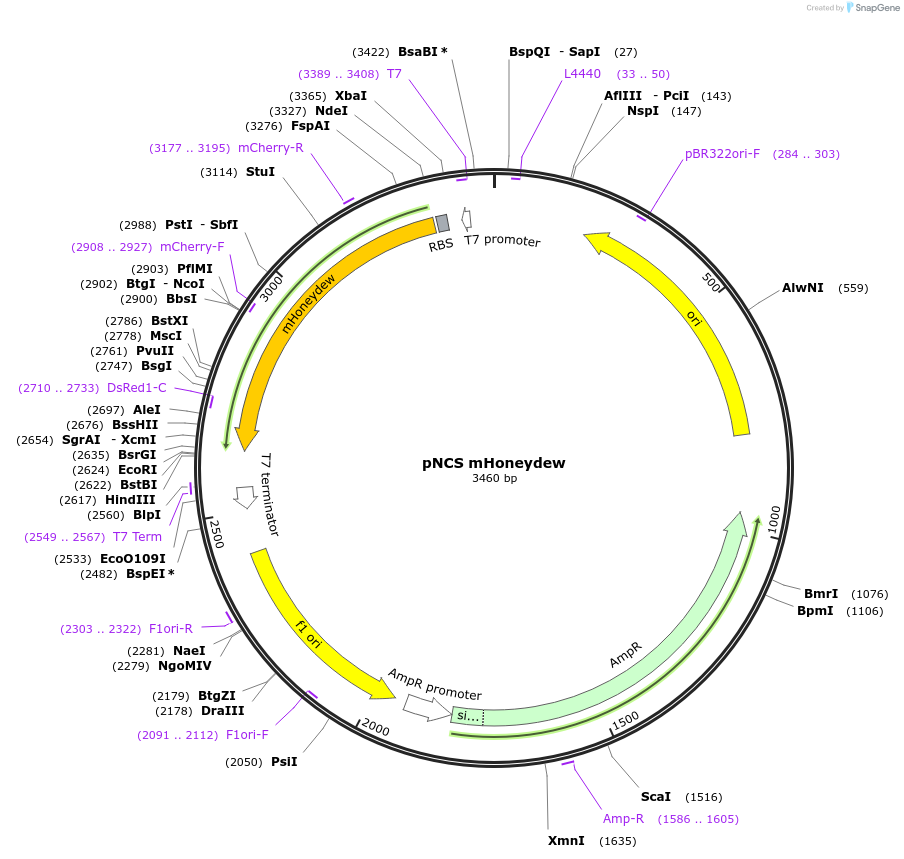-
PurposeBacterial expression of a fluorescent protein, monomeric Honeydew (mHoneydew)
-
Depositing Labs
-
Sequence Information
Ordering
| Item | Catalog # | Description | Quantity | Price (USD) | |
|---|---|---|---|---|---|
| Plasmid | 91760 | Standard format: Plasmid sent in bacteria as agar stab | 1 | $89 | |
Backbone
-
Vector backbonemodified pRSETB
-
Backbone manufacturerLife Technologies
- Backbone size w/o insert (bp) 2900
-
Vector typeBacterial Expression
Growth in Bacteria
-
Bacterial Resistance(s)Ampicillin, 100 μg/mL
-
Growth Temperature37°C
-
Growth Strain(s)DH5alpha
-
Growth instructionsE. coli expressing T7 polymerase necessary for fluorescent protein production. Expresses fluorescent protein constitutively. Do not add IPTG.
-
Copy numberHigh Copy
Gene/Insert
-
Gene/Insert namemonomeric Honeydew
-
Alt namemHoneydew
-
SpeciesDiscosoma sp. (mushroom coral)
-
Insert Size (bp)735
- Promoter T7
-
Tag
/ Fusion Protein
- no tags
Cloning Information
- Cloning method Restriction Enzyme
- 5′ cloning site BamHI (not destroyed)
- 3′ cloning site EcoRI (not destroyed)
- 5′ sequencing primer T7 Promoter Forward
- 3′ sequencing primer T7 Terminator
- (Common Sequencing Primers)
Resource Information
-
Article Citing this Plasmid
Terms and Licenses
-
Academic/Nonprofit Terms
-
Industry Terms
- Not Available to Industry
Trademarks:
- Zeocin® is an InvivoGen trademark.
Depositor Comments
These plasmids are used in University Molecular Biology Laboratories and by High School students to purify fluorescent proteins and create fluorescent protein plate artwork.
These plasmids were created by your colleagues. Please acknowledge the Principal Investigator, cite the article in which the plasmids were described, and include Addgene in the Materials and Methods of your future publications.
-
For your Materials & Methods section:
pNCS mHoneydew was a gift from Erik Rodriguez & Roger Tsien (Addgene plasmid # 91760 ; http://n2t.net/addgene:91760 ; RRID:Addgene_91760) -
For your References section:
Improved monomeric red, orange and yellow fluorescent proteins derived from Discosoma sp. red fluorescent protein. Shaner NC, Campbell RE, Steinbach PA, Giepmans BN, Palmer AE, Tsien RY. Nat Biotechnol. 2004 Dec;22(12):1567-72. Epub 2004 Nov 21. 10.1038/nbt1037 PubMed 15558047



